NCERT Solution: Circles
Let AB be a diameter of the circle. Two tangents PQ and RS are drawn at points A and B respectively.
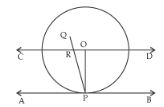
Let AB be the tangent to the circle at point P with centre O.
We have to prove that PQ passes through the point O.
Suppose that PQ doesn't passes through point O. Join OP.
Through O, draw a straight line CD parallel to the tangent AB.
PQ intersect CD at R and also intersect AB at P.
AS, CD // AB PQ is the line of intersection,
∠ORP = ∠RPA (Alternate interior angles)
but also,
∠RPA = 90° (PQ ⊥ AB)
⇒ ∠ORP = 90°
∠ROP + ∠OPA = 180° (Co-interior angles)
⇒∠ROP + 90° = 180°
⇒∠ROP = 90°
Thus, the ΔORP has 2 right angles i.e. ∠ORP and ∠ROP which is not possible.
Hence, our supposition is wrong.
∴ PQ passes through the point O.
AB is a tangent drawn on this circle from point A.
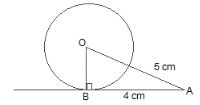
∴ OB ⊥ AB
OA = 5cm and AB = 4 cm (Given)
In ΔABO,
By Pythagoras theorem in ΔABO,
OA2 = AB2 + BO2
⇒ 52 = 42 + BO2
⇒ BO2 = 25 - 16
⇒ BO2 = 9
⇒ BO = 3
∴ The radius of the circle is 3 cm.
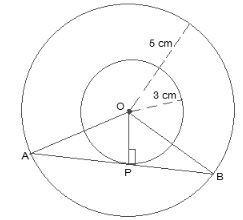
Let the two concentric circles with centre O.
AB be the chord of the larger circle which touches the smaller circle at point P.
∴ AB is tangent to the smaller circle to the point P.
⇒ OP ⊥ AB
By Pythagoras theorem in ΔOPA,
OA2 = AP2 + OP2
⇒ 52 = AP2 + 32
⇒ AP2 = 25 - 9
⇒ AP = 4
In ΔOPB,
Since OP ⊥ AB,
AP = PB (Perpendicular from the center of the circle bisects the chord)
AB = 2AP = 2 × 4 = 8 cm
∴ The length of the chord of the larger circle is 8 cm.
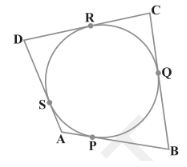
From the figure we observe that,
DR = DS (Tangents on the circle from point D) … (i)
AP = AS (Tangents on the circle from point A) … (ii)
BP = BQ (Tangents on the circle from point B) … (iii)
CR = CQ (Tangents on the circle from point C) … (iv)
Adding all these equations,
DR + AP + BP + CR = DS + AS + BQ + CQ
⇒ (BP + AP) + (DR + CR) = (DS + AS) + (CQ + BQ)
⇒ CD + AB = AD + BC
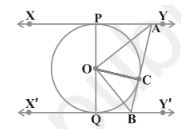
In ΔOPA and ΔOCA,
OP = OC (Radii of the same circle)
AP = AC (Tangents from point A)
AO = AO (Common side)
∴ ΔOPA ≅ ΔOCA (SSS congruence criterion)
⇒ ∠POA = ∠COA … (i)
Similarly,
ΔOQB ≅ ΔOCB
∠QOB = ∠COB … (ii)
Since POQ is a diameter of the circle, it is a straight line.
∴ ∠POA + ∠COA + ∠COB + ∠QOB = 180 º
From equations (i) and (ii),
2∠COA + 2∠COB = 180º
⇒ ∠COA + ∠COB = 90º
⇒ ∠AOB = 90°
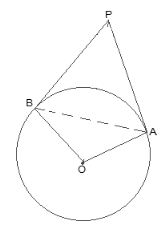
Consider a circle with centre O. Let P be an external point from which two tangents PA and PB are drawn to the circle which are touching the circle at point A and B respectively and AB is the line segment, joining point of contacts A and B together such that it subtends ∠AOB at center O of the circle.
It can be observed that
OA ⊥ PA
∴ ∠OAP = 90°
Similarly, OB ⊥ PB
∴ ∠OBP = 90°
In quadrilateral OAPB,
Sum of all interior angles = 360º
∠OAP +∠APB +∠PBO +∠BOA = 360º
⇒ 90º + ∠APB + 90º + ∠BOA = 360º
⇒ ∠APB + ∠BOA = 180º
∴ The angle between the two tangents drawn from an external point to a circle is supplementary to the angle subtended by the line-segment joining the points of contact at the centre.
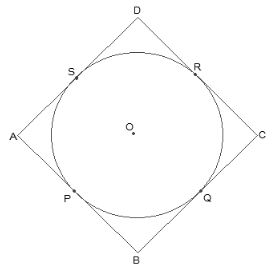
ABCD is a parallelogram,
∴ AB = CD ... (i)
∴ BC = AD ... (ii)
From the figure, we observe that,
DR = DS (Tangents to the circle at D)
CR = CQ (Tangents to the circle at C)
BP = BQ (Tangents to the circle at B)
AP = AS (Tangents to the circle at A)
Adding all these,
DR + CR + BP + AP = DS + CQ + BQ + AS
⇒ (DR + CR) + (BP + AP) = (DS + AS) + (CQ + BQ)
⇒ CD + AB = AD + BC ... (iii)
Putting the value of (i) and (ii) in equation (iii) we get,
2AB = 2BC
⇒ AB = BC ... (iv)
By Comparing equations (i), (ii), and (iv) we get,
AB = BC = CD = DA
∴ ABCD is a rhombus.
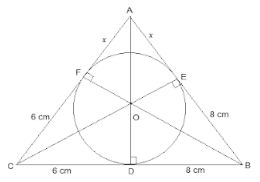
In ΔABC,
Length of two tangents drawn from the same point to the circle are equal,
∴ CF = CD = 6cm
∴ BE = BD = 8cm
∴ AE = AF = x
We observed that,
AB = AE + EB = x + 8
BC = BD + DC = 8 + 6 = 14
CA = CF + FA = 6 + x
Now semi perimeter of triangle (s) is,
⇒ 2s = AB + BC + CA
= x + 8 + 14 + 6 + x
= 28 + 2x
⇒s = 14 + x
Area of ΔABC = √s (s - a)(s - b)(s - c)
= √(14 + x) (14 + x - 14)(14 + x - x - 6)(14 + x - x - 8)
= √(14 + x) (x)(8)(6)
= √(14 + x) 48 x ... (i)
also, Area of ΔABC = 2×area of (ΔAOF + ΔCOD + ΔDOB)
= 2×[(1/2×OF×AF) + (1/2×CD×OD) + (1/2×DB×OD)]
= 2×1/2 (4x + 24 + 32) = 56 + 4x ... (ii)
Equating equation (i) and (ii) we get,
√(14 + x) 48 x = 56 + 4x
Squaring both sides,
48x (14 + x) = (56 + 4x)2
⇒ 48x = [4(14 + x)]2/(14 + x)
⇒ 48x = 16 (14 + x)
⇒ 48x = 224 + 16x
⇒ 32x = 224
⇒ x = 7 cm
Hence, AB = x + 8 = 7 + 8 = 15 cm
CA = 6 + x = 6 + 7 = 13 cm